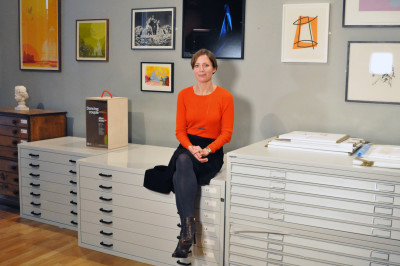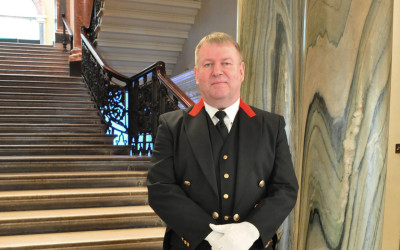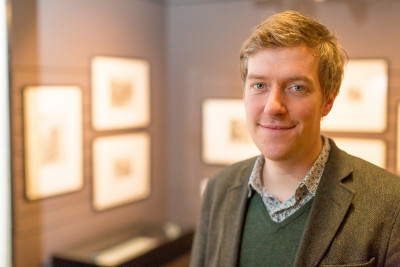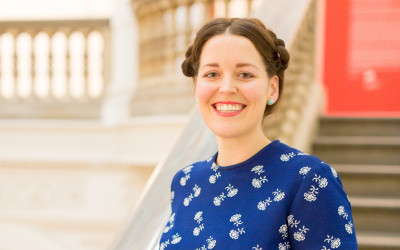A day in the life: Ella Riley, Senior Buyer for the RA Shop
A day in the life: Ella Riley, Senior Buyer for the RA Shop
Eight questions about working at the RA
By Harriet Baker
Published 15 October 2015
From sourcing exciting products for the RA Shop to collaborating directly with artists, no day at the RA is ever the same for Ella Riley.
-
How did you come to work at the RA?
Perhaps astonishingly, I have worked at the RA for over 18 years. The first exhibition I worked on here was Monet in the 20th Century, which was in 1997.
I have a strong background in the arts as both of my parents were artists, so perhaps it was inevitable that I took the same path and studied for a degree in Fine Art. When I left art college, my first job was working for the British Council. They had a rigorous training programme for new starters, which covered all aspects of working for a large organisation, and I certainly took advantage of it. It has stood me in good stead at the Royal Academy.
Afterwards, I set up my own business with the support of the Prince’s Trust Enterprise Scheme – designing and making objets d’art for the interior design industry – which gave me invaluable experience in running a creative business. During this time I was also a practising artist, but I supplemented this with part time jobs, including weekend work at the Royal Academy shop. My goal was always to have a career in the arts and so when a job became available for a buyer’s assistant role at the RA it seemed a natural progression for me to apply.
What does a typical day at the RA look like?
It’s a very busy working environment at the RA, and no day is the same. As part of my role, I source and develop product ranges for six exhibitions every year – from blockbuster exhibitions like Ai Weiwei to the more specialist shows in the Sackler Galleries – plus three artist ranges for our core range in the RA Shop. These are often collaborations with Royal Academicians; for example, the most recent range was a collaboration between the RA and Mali Morris. We design a range of products which reflect the visual themes and colour motifs of the artist, which is very exciting.
The buying team have to work very closely with other departments on a wide range of projects, so there is a constant flow of creative ideas alongside managing the product development process and meeting suppliers face-to-face. We also have internal meetings with the heads of the buying, retail and e-commerce teams. We have recently relaunched the e-commerce site which has enabled us to increase the online product offer across all categories for this growing business.
-

Lisa Milroy RA designed a silk kimono for the RA Shop

A David Hockney-inspired ashtray, designed for the artist's 2012 exhibition at the RA

Humphrey Ocean RA Amber Static Card
-
What projects have you enjoyed working on?
Over the years I have worked with many artists who have made a considerable contribution to the shop. For example, during past collaborations with the late Academicians Mary Fedden and Terry Frost, we found that they had a very hands-on approach with the design process which was great fun. I have also enjoyed working with contemporary artists, such as the Academicians Gary Hume, Humphrey Ocean, Lisa Milroy, and Barbara Rae. The collaborative relationship with the artist can vary; during some projects the buyers will lead the creative concept by submitting proposed designs to the artist, but sometimes the artist may produce a bespoke design for a specific product. For example, Lisa Milroy RA designed a limited edition silk kimono for the core range. Working so closely with these artists and having the opportunity to design unique products with them is hugely rewarding.
The buying team have to work closely with many other departments in the gallery to ensure that the merchandise we’re selling is relevant, “on brand” and will optimise sales. The products in the RA Shop need to reflect the content and themes of the exhibition, and so early on in the exhibition process we meet with the curators to gain an understanding of their goals. We also work closely with the RA Publications team on the exhibition catalogues, and with the Press and Marketing departments to make sure we’re in line with the marketing campaign.
What exhibition have you most enjoyed?
I have worked on so many exhibitions over the past 18 years! Highlights would be the great cultural surveys of the Turks, China and the Aztecs. It was wonderful because we sourced beautiful handcrafted artisanal products direct from the suppliers. David Hockney: A Bigger Picture was a very memorable and proud moment in my career. I worked with one of the greatest living artists on a hugely successful range of products, including a best-selling ash tray and a cigarette tin which I developed at special request from Hockney himself!
Tell us something that most people don’t know about your job role.
The job is a very creative role which involves researching ideas, finding new suppliers and working closely with artists on bespoke commissions. The exhibition range for Ai Weiwei, which launched in September, is a good example of this kind of collaboration. We developed an extensive range of products to appeal to a wide audience, and the artist was involved with many stages of the development. He has been very supportive and has also designed specific products especially for our exhibition. For example, the wooden push up figure of the artist – one of the best-selling pieces – is apparently his favourite item. Ai Weiwei is proving to be a huge success and we have had a fantastic response to the merchandise, with sales way above our planned forecast. Everybody wants a piece of Ai Weiwei, so they want a piece of the merchandise too.
-
What’s special about working at the RA?
The Royal Academy is a unique place. I have worked alongside like-minded people who are as passionate and dedicated to their jobs as I am, which is a real privilege.
What advice would you give to someone wanting to go into a career in the arts?
The arts is a highly competitive sector and there is not an obvious route into it. For buying for a gallery or arts institution, you would need to have a background in art and art history, paired with a good commercial eye and an understanding of customer profiles. Negotiating skills are also very important – from being able to talk to artists to working out the best financial deal with a supplier.
What are your future ambitions?
I’m very excited about the plans to extend the Royal Academy in time for its 250th anniversary, and am looking forward to this amazing opportunity for the gallery in 2018. I’ll be heavily involved in the implementation of our retail strategy, as the new spaces in Burlington House will include newly-designed shops.
-

Ai Weiwei wooden push-up figure, available exclusively from the RA Shop
-
Visit the RA Shop website to see the Ai Weiwei product range, and the latest artist collaboration with Mali Morris RA.








